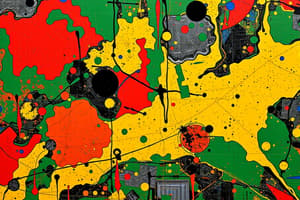Podcast
Questions and Answers
Which of the following are toxic metals? (Select all that apply)
Which of the following are toxic metals? (Select all that apply)
- Copper (correct)
- Zinc (correct)
- Lead (correct)
- Iron
What is toxic-metal poisoning?
What is toxic-metal poisoning?
Illness caused when toxic metals are absorbed from utensils or equipment containing them.
Which of the following are examples of chemical hazards? (Select all that apply)
Which of the following are examples of chemical hazards? (Select all that apply)
- Machine lubricants (correct)
- Cleaners (correct)
- Metal shavings
- Sanitizers (correct)
What are steps to prevent chemical contamination?
What are steps to prevent chemical contamination?
Which of the following are examples of physical hazards? (Select all that apply)
Which of the following are examples of physical hazards? (Select all that apply)
What steps can food handlers take to prevent physical contamination?
What steps can food handlers take to prevent physical contamination?
What is food defense?
What is food defense?
What does A.L.E.R.T. stand for?
What does A.L.E.R.T. stand for?
What is a food allergen?
What is a food allergen?
What are the symptoms of a food allergy? (Select all that apply)
What are the symptoms of a food allergy? (Select all that apply)
Which of the following are the most common food allergens? (Select all that apply)
Which of the following are the most common food allergens? (Select all that apply)
What steps can be taken to prevent food allergens?
What steps can be taken to prevent food allergens?
What is cross-contact?
What is cross-contact?
What steps can be taken to prevent cross-contact?
What steps can be taken to prevent cross-contact?
Flashcards are hidden until you start studying
Study Notes
Toxic Metals
- Toxic metals include lead, copper, and zinc, which pose risks to human health.
Toxic-Metal Poisoning
- Illness occurs when toxic metals are absorbed from contaminated utensils or equipment.
Chemical Hazards
- Common examples of chemical hazards in food service are cleaners, sanitizers, polishes, and machine lubricants.
Preventing Chemical Contamination
- Store chemicals away from food prep and service areas.
- Follow manufacturer's directions for using and disposing of chemicals.
- Ensure labels on chemicals are readable.
- Use equipment and utensils approved for foodservice when handling food.
- Purchase chemicals only from approved, reputable suppliers.
Physical Hazards
- Physical hazards in food include metal shavings, staples, glass, plastic shards, dirt, jewelry, and body parts like hair and bandages.
Preventing Physical Contamination
- Tie back hair or use hairnets while preparing food.
- Remove all jewelry except simple wedding bands.
- Wear plastic gloves if hands or fingers are bandaged.
- Avoid acrylic nails in food preparation.
- Maintain clean food prep areas, free from trash.
- Inspect food carefully upon receipt from suppliers.
Food Defense
- Food defense is a program designed to prevent intentional contamination of food.
A.L.E.R.T. Program
- A.L.E.R.T. stands for:
- Assure safe product reception.
- Look for safety threats within the establishment.
- Employees should adhere to security guidelines.
- Maintain accessible reports on food security.
- Identify and report food safety threats to authorities.
Food Allergens
- Food allergens are proteins that cause adverse reactions in individuals, potentially leading to serious health issues.
Symptoms of Food Allergy
- Common symptoms include nausea, wheezing, hives, facial swelling, abdominal cramps, diarrhea, and can lead to death in severe cases.
Common Food Allergens
- Major allergens include milk, eggs, fish, shellfish, wheat, soy, peanuts, and tree nuts.
Preventing Food Allergens
- Servers should describe food preparation methods, identify ingredients, suggest simple menu options, and ensure food for allergy-prone patrons is delivered separately.
Cross-Contact
- Cross-contact refers to the transfer of allergens from an allergenic food to a non-allergenic food, posing health risks.
Preventing Cross-Contact
- Wash, rinse, and sanitize all cookware and utensils.
- Change gloves and wash hands prior to preparing allergen-free food.
- Assign specific equipment for food preparation for allergic customers.
- Label onsite packaged food with allergen information.
Studying That Suits You
Use AI to generate personalized quizzes and flashcards to suit your learning preferences.




